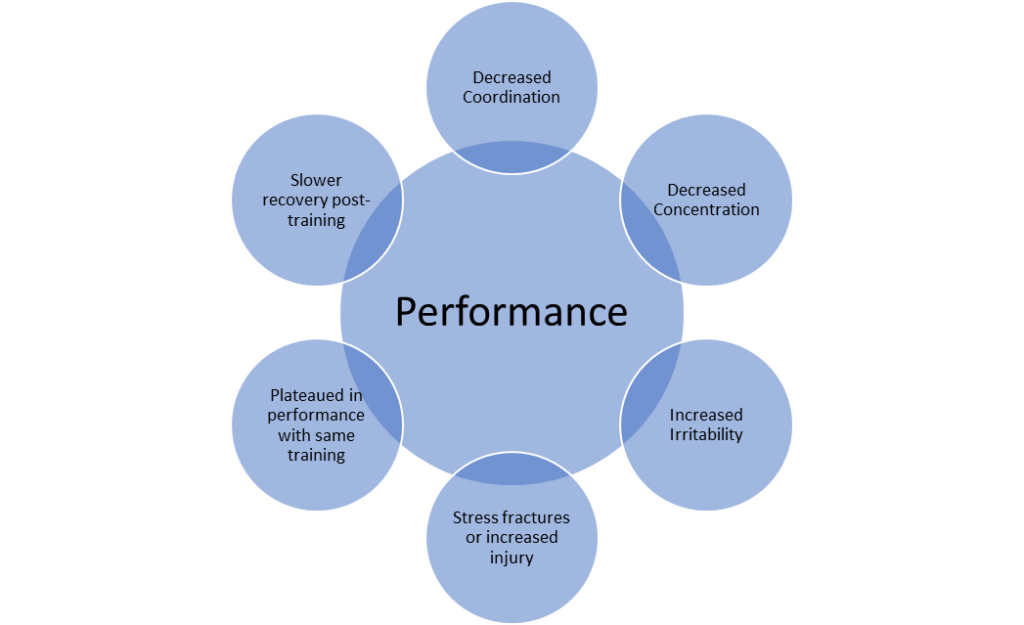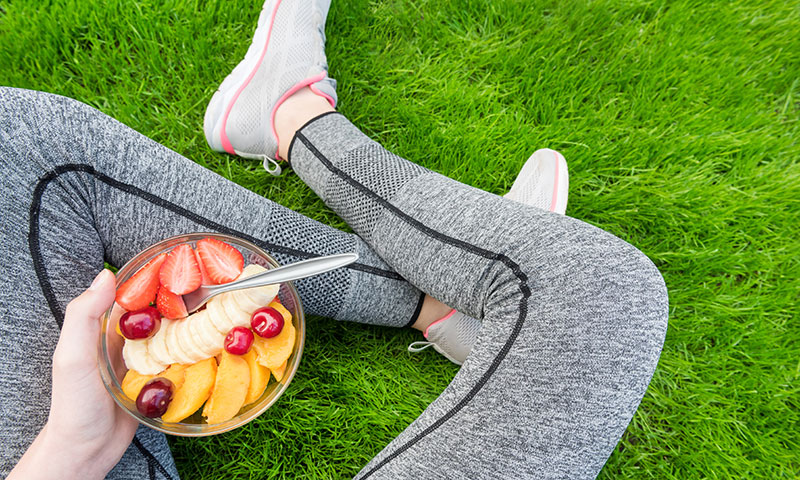When output exceeds input.
As an athlete, the most important resource you have for your performance is your own body. To achieve optimal success requires giving your body everything it needs to meet the demands placed on it each day. This means finding balance in the amount of food, hydration, training and rest. Input must balance output or our body begins to break down, physically and mentally. Failure to give our body sufficient caloric intake to support all of the bodily functions involved in health and performance can contribute to a condition known as Relative Energy Deficiency in Sport, or RED-S. This month’s blog will help educate you on what to watch for and how to keep your body in tip-top condition.
Why is it important?
As an athlete, you are training and competing hard every day, so it is especially important to keep your body properly fueled with sufficient energy from the food you eat. A mismanaged diet can put you at risk for not having enough available energy for the body’s needs. Sometimes this fuel deficiency shows up immediately, as in decreased performance. More often than not, however, it shows up over an extended period of time and may even have long-term consequences for future health.
The resulting syndrome of Relative Energy Deficiency in Sport reflects the imbalance between dietary intake and energy expenditure required to support health, daily life and training needs. Serious long-term consequences include problems with menstrual and reproductive health, metabolism, and immunity, along with nutrient deficiencies and dehydration. In addition, stomach problems are common, and hormone changes can lead to weakened bone health, putting you at risk for stress fractures and osteoporosis.
Who is at risk for RED-S?
While more common in female athletes, males are affected, too. The most common occurrence happens when an athlete mismanages their diet in relation to their training. Particularly in sports like track, ice skating, or gymnastics, it may be tempting to think that if you just drop a few pounds, you will perform better. As a result of the weight loss, you may even experience short term gains in performance, giving a false sense of confidence. In addition, coaches or teammates may add to the mixed messages by complimenting your leaner body.
Even over as short as a one month period, however, the body begins to suffer from the miscalculation. As the athlete decreases caloric intake or increases training load, the body can no longer meet the demands, resulting in things like menstrual changes, mood changes and more frequent illness or injuries. Eventually, performance suffers. Perhaps you are no longer making gains in speed or taking longer to recover than teammates. Emotional stress, like depression, may also contribute to or occur as a result of RED-S.
Recognizing RED-S Flags
How can you tell if you are at risk for RED-S? While the symptoms can be subtle, it is important to pay attention to the big picture. Check out the diagrams here, and if one or more of these symptoms fits you, talk to your trainer or doctor.
Do you have to have an eating disorder to have RED-S?
No! Managing your diet to meet your body’s needs can be difficult when you are training to win. Decreasing calories or increasing training can cause nutrient imbalances. Consulting with your training team and/or a nutritionist can be a great way to ensure you stay in tip-top shape.

Work smarter, not harder.
Self-confidence has consistently been shown as the primary factor influencing performance. Confidence can help buffer against disappointing losses and setbacks, and can improve your concentration and positive emotions. Sometimes we confuse confidence with perfection, thinking that you have to be someone else’s idea of perfection to believe in yourself. A more helpful mindset is one of excellence. An excellence mindset is built from the inside-out. It starts with curiosity, wondering just what you are capable of, and then using each training and competition as feedback from which you adapt and grow.
Building authentic confidence, brick by brick.
Authentic confidence is built one day at a time. It starts by believing you can get the job done, whether that is sticking to your training routine, studying for a test or recovering from injury. It’s like building a wall, brick by brick. Each day you show up and support yourself with positive actions toward your goal, you are stacking bricks to build your wall of confidence.
Remember that as an athlete, the road to success has many bumps. Sometimes self-doubt and negative thoughts creep in, and this is completely normal. Having some mental tools in your belt will help you stay strong in the face of doubt. Try some of the mental tips below to give yourself some confidence momentum.
7 Mental Performance tips for boosting confidence:
- Focus on process rather than outcome. Set small goals that are in your control and help move you toward the larger goals. Proper fueling, hydration and sleep are some examples.
- Use positive body language, which can translate into positive emotions. Smile, hold your head up and stand tall.
- Use positive self-talk, phrasing things positively with “I will” instead of “I hope I don’t”.
- Visualize it! Take a few minutes daily to practice seeing yourself succeed in a variety of situations.
- Set and stick to your training schedules. You will feel empowered when you follow through with your commitments.
- Keep a confidence journal. Each day, write 3-4 short sentences, noting what you did that day and something you can feel good about. Over time, you can look back and see how far you’ve come.
- Celebrate each little victory! Success doesn’t just happen with a medal at the end. It is something you can celebrate each day you show up for yourself.
You are not alone. Where to go if you need help.
Athletes are often told to be mentally tough, but seldom is the meaning of this concept discussed. Mental toughness is often perceived like a bulldozer, where we push hard through everything, regardless of the circumstances. Real mental toughness, however, means knowing when to push forward, and knowing when to pull back and seek help. Supporting yourself mentally, physically and emotionally is a sign of mental strength and the most effective way to cultivate resilience.
If you feel you may need additional support, connect with your coach, a licensed therapist or a mental performance consultant. For immediate help, reach out to one of the organizations below.
ANAD’s Eating Disorder Helpline – 800-355-7767
988 Suicide and Crisis Lifeline – 9-8-8
Work with Michelle to develop the present moment mindset you need to perform your best.
I specialize in helping athletes develop mental skills that can enhance their sport performance, increase their enjoyment as an athlete, and serve them beyond sport. I develop team programs and provide individual consultations tailored to your individual needs and time commitments. Together we will develop a partnership that maximizes your potential through strategies such as goal-setting, stress management, visualization, emotional regulation and more.
I would love to hear from you! Connect with me today for a FREE CONSULTATION.
References:
Ackerman, K. E., Holtzman, B., Cooper, K. M., Flynn, E. F., Bruinvels, G., Tenforde, A. S., … & Parziale, A. L. (2019). Low energy availability surrogates correlate with health and performance consequences of Relative Energy Deficiency in Sport. British journal of sports medicine, 53(10), 628-633.
What is RED-S?
Relative Energy Deficiency Syndrome, or RED-S, is a syndrome of impaired health and performance that is a result of Low Energy Availability (LEA). In simple terms, it is a syndrome resulting from insufficient energy intake to meet the demands of training. One of the first things an athlete may notice is amennoreah, or absence of menstruation in females, or stress fractures, but there are many other health impacts as well.
What are some of the health implications of RED-S?
Athletes with low energy availability (LEA) were more likely to be at increased risk of menstrual issues, poor bone health, metabolic issues, psychological disorders (including depression), cardiovascular imapirment and gastrointestinal issues.
How can RED-S impact athletic performance?
Athletes with low energy availability (LEA) may experience decreased improvement in training, impaired judgment, decreased coordination, decreased concentration, irritability and depression, and decreased endurance in performance.


